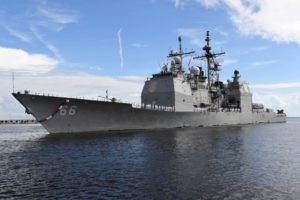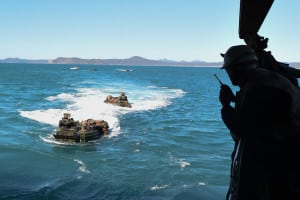The Navy’s top officer this week argued the service’s fiscal year 2023 request to retire 24 ships aims to redirect resources from expensive ship fixes and operating costs to increased weapons production lines and balance other costs.
“Our entering argument is what can we afford, so in other words, you won’t have a Navy bigger than one that we can sustain. So in taking a look at our top line, we then stratified all of our platforms based on their return in the fight. So with respect to lethality, with respect to sustainability, with respect to reliability, could we count on them to actually move the needle in a high end fight with an adversary like China. So that stratification caused ships down at the bottom, as an example, to drop out,” Chief of Naval Operation Adm. Michael Gilday said May 11 in testimony before the House Armed Services Committee (HASC).
He argued that for the Navy to maintain the 24 ships means numbers over quality. To do that, “we’re going to pay for that in terms of people, we’re going to pay for it with less ammunition and magazines, fewer spare parts and store rooms. We’re going to pay for it with reduced maintenance, reduce flying hours, reduced steaming days, everything that will yield you a ready force today.”

In FY ’23 alone, the Navy plans to retire five Ticonderoga-class cruisers, nine Freedom-variant Littoral Combat Ships (LCS), four Whidbey Island/Harpers Ferry-class dock landing ships (LSDs), two submarines, two oilers, and two Expeditionary Transfer Docks (ESDs)
Gilday noted, regardless of these decisions, the size and shape of the Navy will not change much in the next five years, but if conflict with China were to happen within five years, “the fleet that we field today has to be ready to take it on.”
He said the Navy is proposing to reinvest the savings from retiring the two dozen ships into the services’ top priorities of readiness, modernization and lethality.
“So with respect to readiness, we are trying to maximize the domestic production lines for all high end missiles,” including the Lockheed Martin [LMT] Long Range Anti-Ship Missile (LRASM), Joint Air-to-Surface Standoff Missile-Extended Range (JASSM-ER), Raytheon [RTX] Maritime Strike Tomahawk cruise missile, and Raytheon Standard Missile (SM)-6.
Focusing on weapons like this means “that the ships that we do send to sea actually have systems that matter from both a deterrence and from a fight…”
HASC chairman Adam Smith (D-Wash.) then cut Gilday off to sum up the argument.
“If I could just put a fine point on that, right. Rather than spending money on ships that aren’t capable and don’t perform, you would like to spend it so the ships we do have actually have missiles that they can use, which seems to make sense to me.”
Gilday also testified before the Senate Armed Services Committee on May 12 and added to his argument that the Navy is trying to maximize the long range weapons production lines “to send a demand signal so we can fill our magazines with weapons and make sure that if the fight does go down tonight or in the 2027 timeframe that we’re ready to go.”
Gilday also explained at the HASC hearing why each kind of ship the Navy seeks to retire is worth divesting.
He argued the five cruisers the Navy wants to retire have undergone modernization work and combined “they are over eight years in delay days out of shipyards and over a half a billion dollars above budget with respect to the modernization programs.”
Gilday also said the cruisers’ older SPY radar system can’t see the most modern threats, and thus would not be able to shoot them down. In addition, three recently deployed cruisers had to return to port for repairs due to leaks under the waterline and in leaking fuel tanks.

“So there have been survivability, reliability and lethality challenges with the cruisers that are near the end of their service life at 35 years. We think that at this point, we’re throwing good money after bad and…the money that we saved from those cruisers gets reinvested into readiness, into modernization and into capacity, in that order.”
The FY ‘23 budget request plans to retire the USS Germantown (LSD-42), Gunston Hall (LSD-44), Tortuga (LSD-46) and Ashland (LSD-48) in 2023, all Whidbey Island/Harpers Ferry-class dock landing ships. The Navy also plans to retire 10 total LSDs through 2027. The LSDs were expected to have a 40-year service life but are being put on the divestment list between three and 14 years early.
The Navy’s latest 30-year shipbuilding plan said these older ships are in poor material condition and require “significant resources to continue to maintain and operate,” while moving resources to other capabilities better supports the amphibious fleet.
“With respect to the older LSDs, the Tortuga is a really good example. She’s three years delayed coming out of maintenance right now. So these decisions we made… centered around lethality, being able to actually move the needle in a fight, survivability, reliability,” Gilday added.
The CNO also reiterated the “primary reason” nine LCSs are on the retirement list is due to canceling the anti-submarine warfare system, in addition to costs repairing the combining gear engine issue.